Scones
- By Jennifer Segal
- Updated December 1, 2024
- 179 Comments
- Leave a Review

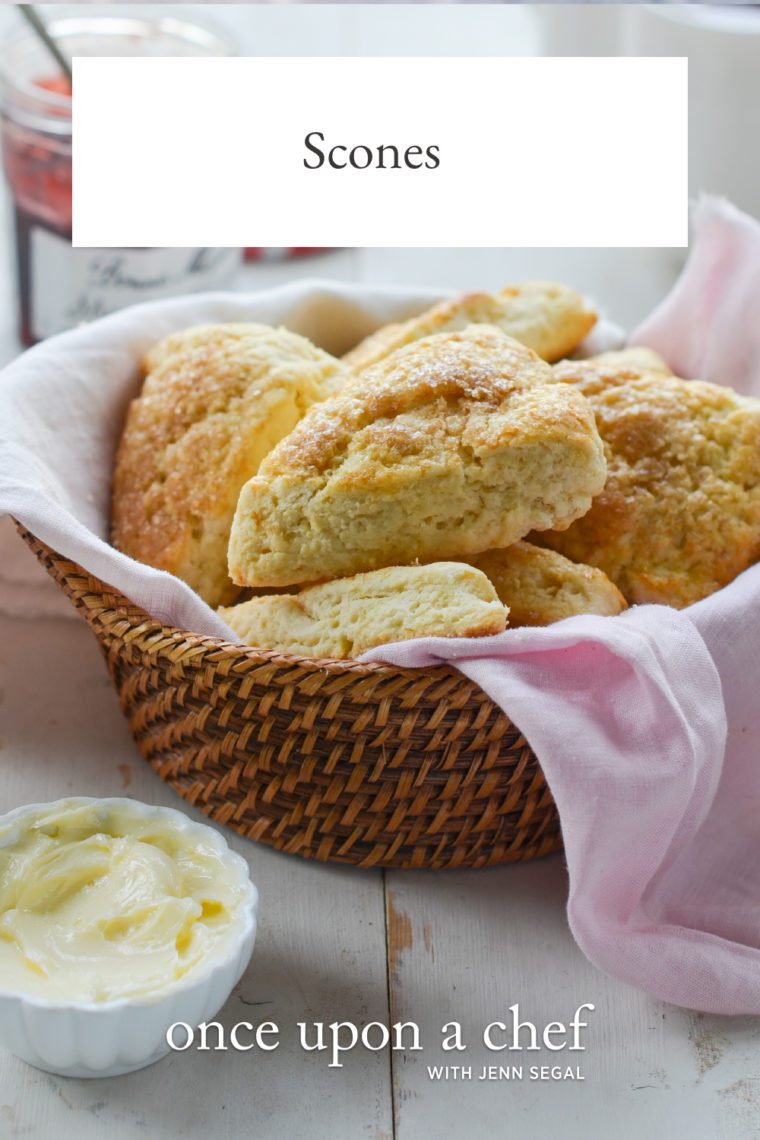
This post may contain affiliate links. Read my full disclosure policy.
Forget the dry, crumbly scones you’ve had before—these are buttery, tender, and just right with coffee or tea.
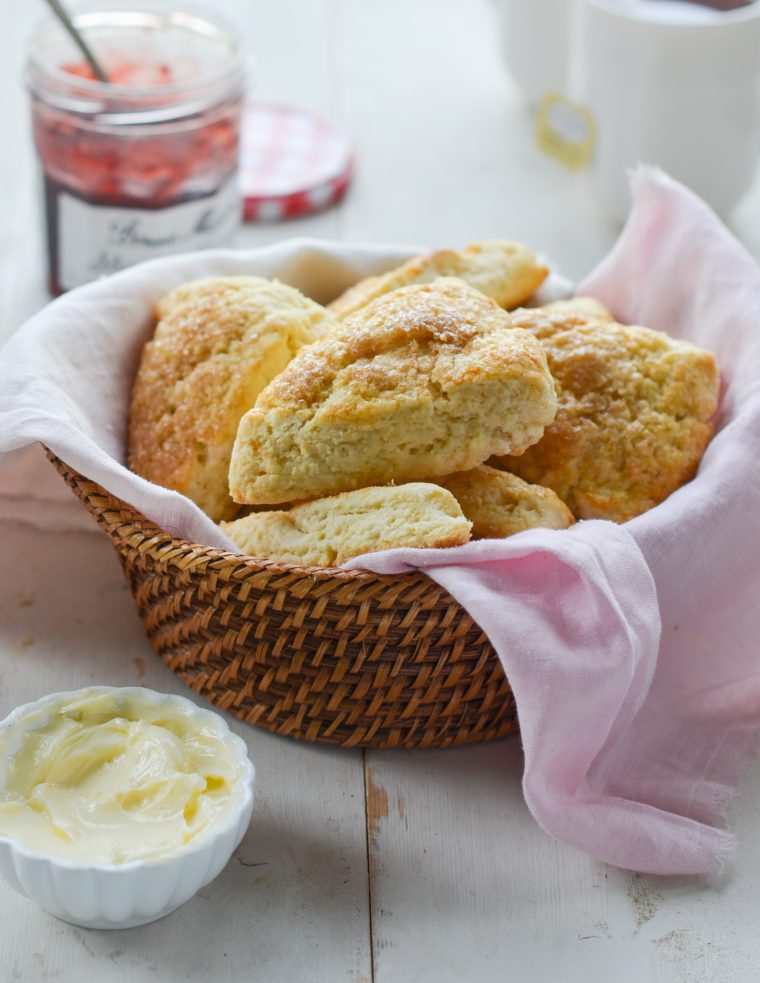
Cousins of American biscuits, scones are a British teatime staple, often enjoyed with butter, jam, or clotted cream. They’re just as popular in American bakeries, where they tend to be sweeter and dressed up with mix-ins or frosting. But let’s face it—scones can sometimes miss the mark. Dry, heavy, and practically begging for a cup of coffee to wash them down! If that’s been your experience, my scone recipe, which makes light, tender, buttery scones, will absolutely change your mind. The secret? Cake flour instead of all-purpose. Its lower protein content makes for ultra-tender scones.
“After living in the U.K. for 5 years and enjoying their high tea I’ve been on the lookout for the perfect scone recipe…this is it!!”
What You’ll Need To Make Scones
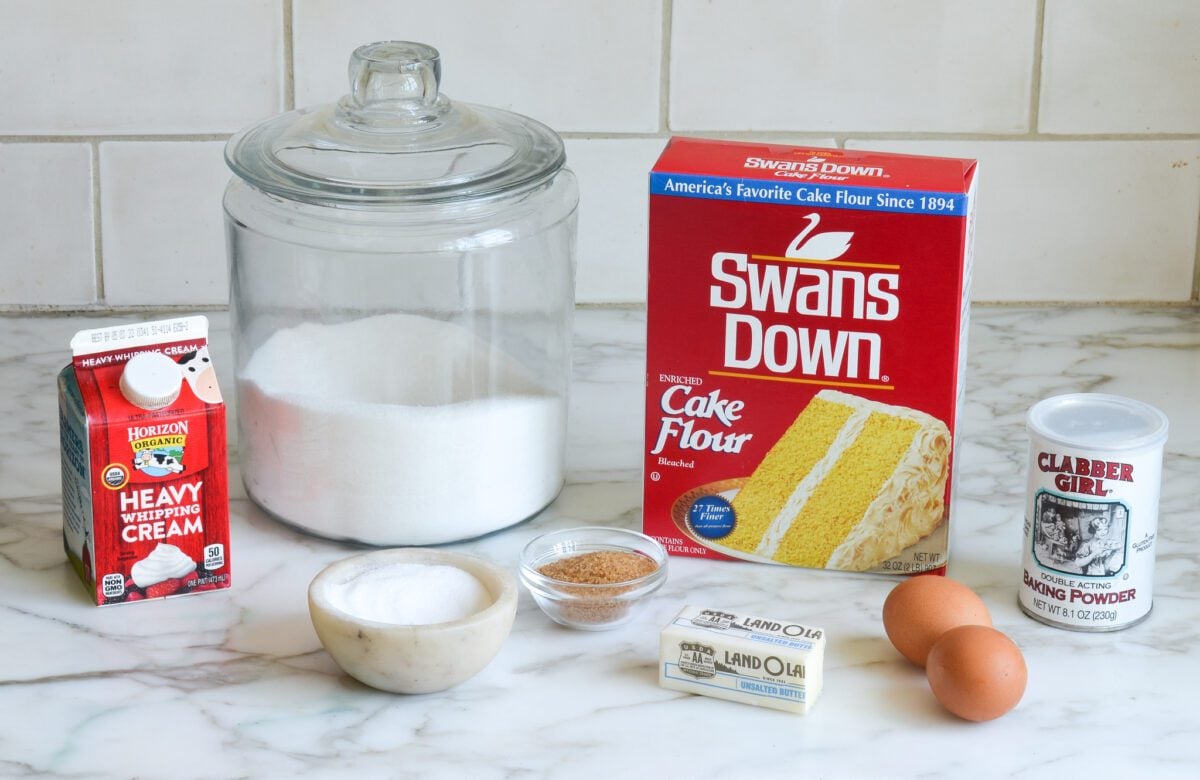
- Cake flour, baking powder, sugar and salt: Cake flour is the foundation of the scones and gives them their tender, delicate crumb. (If you don’t have any on hand, you can make your own—just whisk together 1¾ cups all-purpose flour and ¼ cup cornstarch.) Baking powder helps the scones rise and become light and fluffy. Salt and sugar flavor the dough.
- Butter: Adds richness, flavor, and a tender crumb to the scones. Make sure to use very cold butter—those little solid bits in the dough release steam as they melt in the oven, creating the flaky layers that make scones so good.
- Eggs & Heavy Cream: One egg is mixed with the cream to enrich the dough and give the scones their rich texture, while the other is brushed on top before baking for a golden finish.
- Demerara Sugar: (Also called raw or turbinado sugar) A sprinkle over the tops gives the scones a crunchy, caramel-y finish.
- Jump to the printable recipe for precise measurements
Step-By-Step Instructions
Step 1. Mix the dry ingredients and butter. In a large bowl, whisk together the cake flour, baking powder, sugar, and salt. Add the cold butter, cut into small pieces.
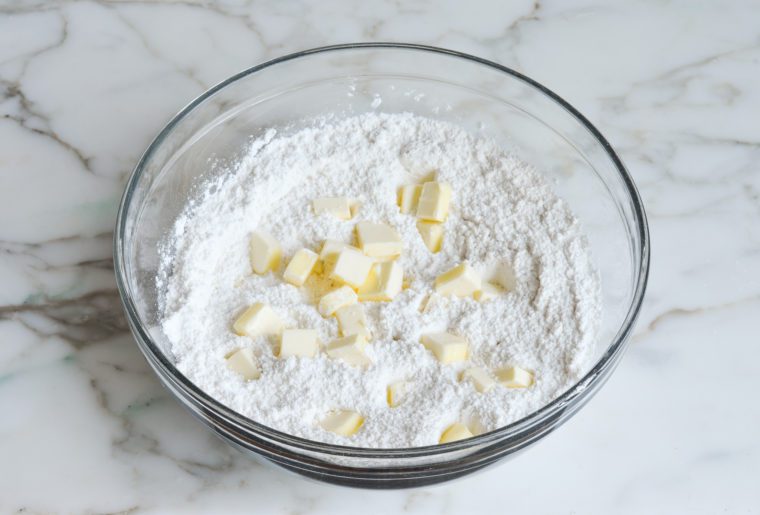
Step 2. Rub the butter into the flour mixture. Use your fingertips to work the butter into the dry ingredients until the mixture looks like coarse crumbs with pea-size bits of butter.
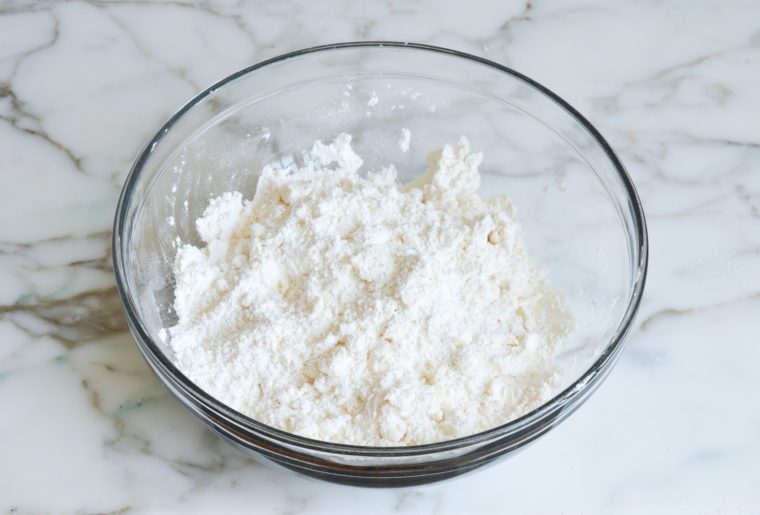
Step 3. Add the cream and egg mixture. In a small bowl or measuring cup, whisk ⅔ cup heavy cream with one egg. Make a well in the center of the dry ingredients and pour the liquid in.
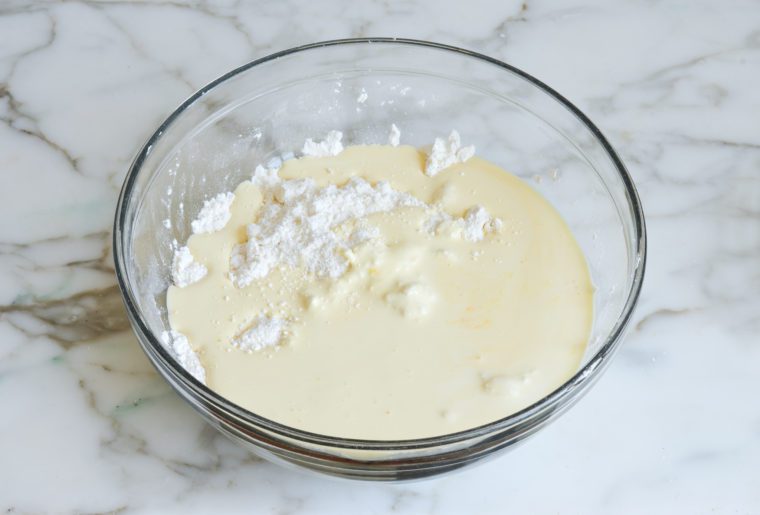
Step 4. Bring the dough together. Mix with a rubber spatula until the dough forms a mass. It should be a bit sticky but manageable. If it feels dry, add the remaining 2 tablespoons cream.
Pro Tip: Aim for a shaggy texture. A few dry spots are fine—overmixing will make the scones dense.
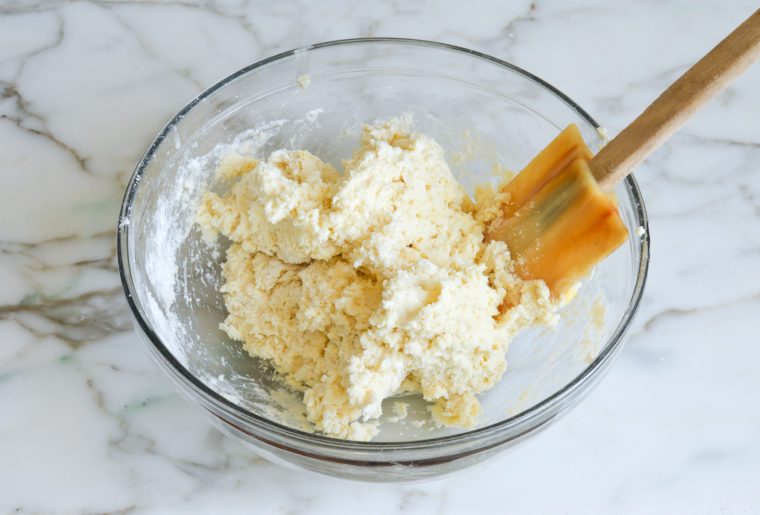
Step 5. Turn dough onto a floured surface. Lightly flour your work area and transfer the dough onto it.
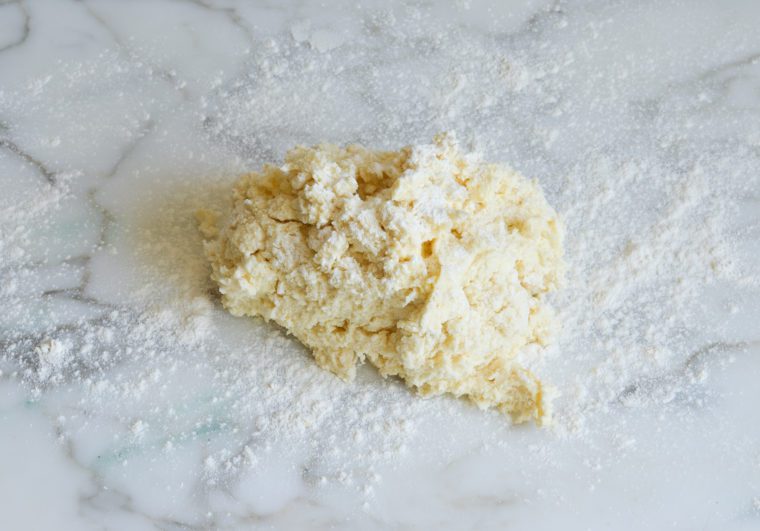
Step 6. Knead and shape. Gently knead a few times until the dough forms a ball. (Sprinkle more flour, little by little, if dough is too sticky to work with.) Pat into a 7-inch round, about ¾ inch thick.
Pro Tip: Definitely not imperative, but if you happen to have a bench scraper, that works well to lift and turn the dough—it controls stickiness and keeps the butter cold.
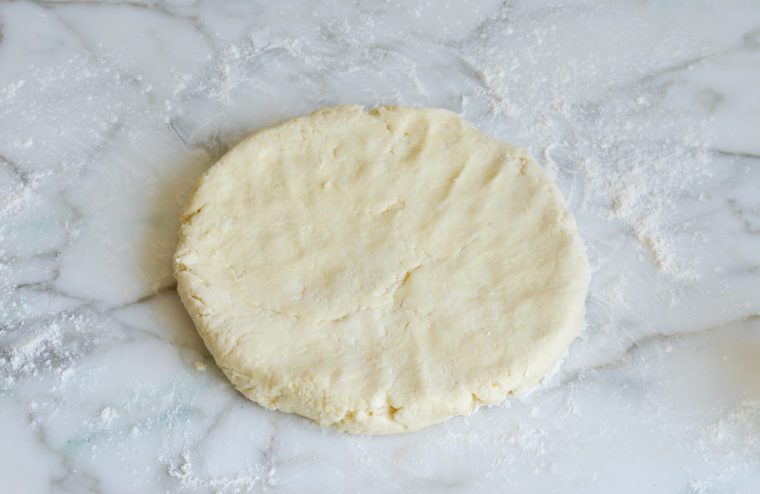
Step 7. Cut and prepare for baking. Slice into 8 wedges, transfer to a parchment-lined baking sheet, brush with beaten egg, and sprinkle with demerara sugar.
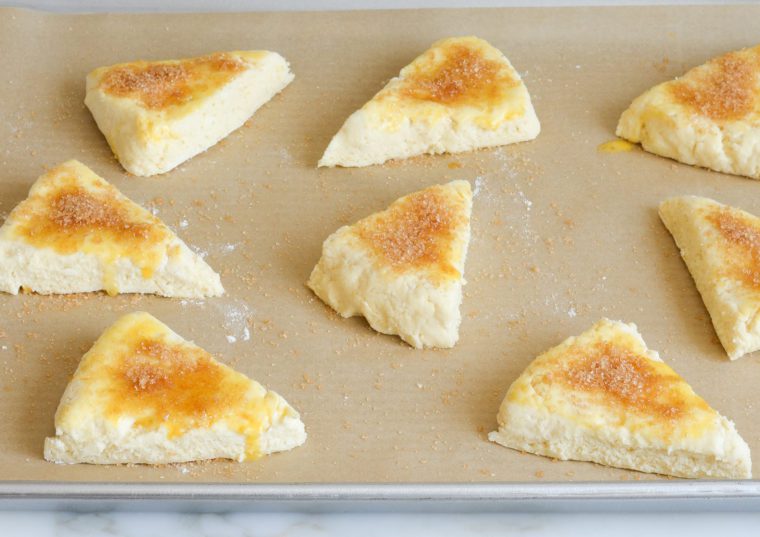
Step 8. Bake. Bake at 425°F for 10 to 12 minutes, until lightly golden brown and firm on top. Serve warm. Both unbaked and baked scones can be frozen for up to three months, but to yield the best results, freeze before baking.
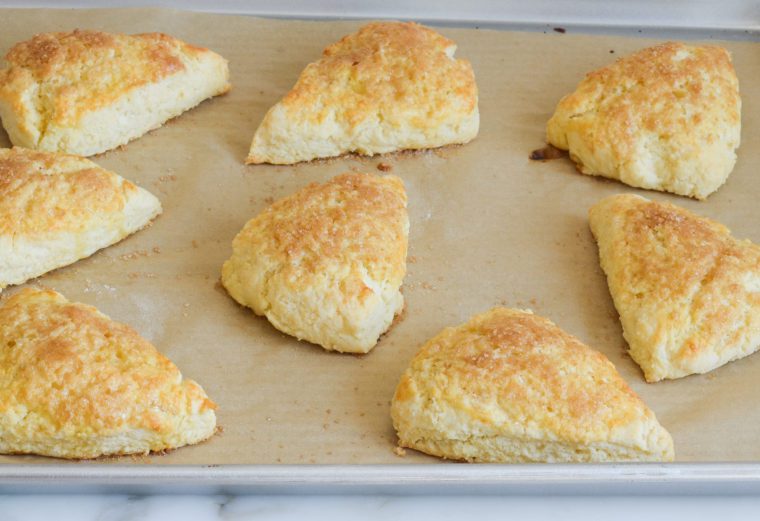
More Ways to Love Scones
From buttery sweet scones to savory scones with a cheesy twist, there are endless recipe variations and add-ins you can try once you’ve mastered the basic scone dough.
- Pumpkin Scones: Inspired by Starbucks’ iconic pumpkin scones, these are packed with pumpkin flavor and perfect for fall mornings.
- Chocolate Chip Scones: With plenty of melty chocolate in every bite, these treats are perfect with coffee, tea, or straight off the baking sheet. Kids love them!
- Blueberry Scones: Tender, fruity scones loaded with berries, and finished with a lemony glaze. They scream brunch.
- Butterscotch Pecan Scones: These butterscotch pecan scones are tender, sweet, and rich – almost like giant cookies.
- Glazed Oatmeal Maple Scones: These delicious scones are studded with pecans and currants and topped with a maple glaze.
Video Tutorial
More Breakfast Recipes You May Like
Scones

Simple, homemade scones—light, tender, and delicious every time.
Ingredients
For The Dough
- 2 cups cake flour, spooned into measuring cup and leveled off (see note on substitution)
- 2½ teaspoons baking powder
- 2½ tablespoons sugar
- Scant ¾ teaspoon salt
- 1 stick (½ cup) cold unsalted butter, cut into ½-inch pieces
- 1 large egg
- ⅔ cup heavy cream (do not substitute milk or light cream), plus more if needed
For The Topping
- 1 large egg, beaten
- 1 tablespoon demerara sugar (also called raw sugar or turbinado; optional)
Instructions
- Preheat the oven to 425°F and set an oven rack in the middle position. Line a baking sheet with parchment paper.
- In a large bowl, whisk together the flour, salt, baking powder and granulated sugar. Add the pieces of cold butter. Using your fingertips, rub the butter into the dry ingredients until the mixture resembles coarse crumbs with pea-size clumps of butter within.
- In a small bowl or liquid measuring cup, whisk together the heavy cream and the egg. Make a well in center of dry ingredients, then pour the cream/egg mixture in. Using a rubber spatula, mix until the dough comes together into a mass. It should be a bit sticky but not so wet that you can't handle it with your hands. If it seems dry, add 1 to 2 tablespoons more cream.
- Dust a work surface lightly with flour, then dump the scone dough onto the surface; dust the dough with a bit of flour as well. Knead very gently a few times until the dough comes together into a ball. (Sprinkle more flour, little by little, if dough is too sticky to work with.) Press the dough into a flat circle about 7 inches in diameter and ¾-inch thick, then use a sharp knife to cut into 8 even triangles. Transfer the wedges to the prepared baking sheet. Brush lightly with the beaten egg and sprinkle with the demerara sugar, if using. Bake for 11 to 13 minutes, until the tops are lightly golden and firm to the touch. Serve warm from the oven.
- Note: If you don't have cake flour, you can make your own: simply whisk together 1¾ cups all-purpose flour and ¼ cup cornstarch.
- Freezer-Friendly Instructions: To freeze before baking, place the raw scones on a baking sheet, let set in the freezer, then place in an airtight container and freeze for up to 3 months. Bake as needed directly from the freezer. (Allow 1 to 2 minutes longer in the oven.) To freeze after baking, let the scones cool completely and store in an airtight container for up to 3 months. Before serving, remove the scones from the container and let them come to room temperature. (If you have the option to freeze the scones before or after baking them, you will get the best results if you freeze before baking.)
Nutrition Information
Powered by ![]()
- Per serving (8 servings)
- Serving size: 1 scone
- Calories: 322
- Fat: 20 g
- Saturated fat: 12 g
- Carbohydrates: 33 g
- Sugar: 6 g
- Fiber: 1 g
- Protein: 4 g
- Sodium: 188 mg
- Cholesterol: 76 mg
This website is written and produced for informational purposes only. I am not a certified nutritionist and the nutritional data on this site has not been evaluated or approved by a nutritionist or the Food and Drug Administration. Nutritional information is offered as a courtesy and should not be construed as a guarantee. The data is calculated through an online nutritional calculator, Edamam.com. Although I do my best to provide accurate nutritional information, these figures should be considered estimates only. Varying factors such as product types or brands purchased, natural fluctuations in fresh produce, and the way ingredients are processed change the effective nutritional information in any given recipe. Furthermore, different online calculators provide different results depending on their own nutrition fact sources and algorithms. To obtain the most accurate nutritional information in a given recipe, you should calculate the nutritional information with the actual ingredients used in your recipe, using your preferred nutrition calculator.
See more recipes:
Comments
Add a Comment Cancel reply
This site uses Akismet to reduce spam. Learn how your comment data is processed.

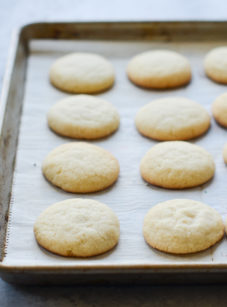
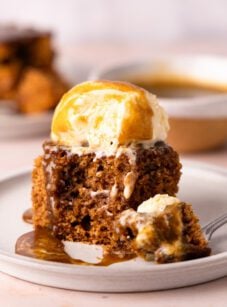
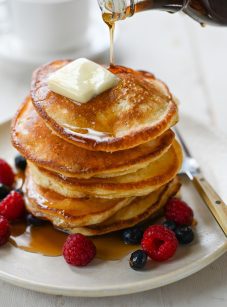
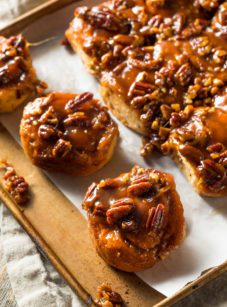


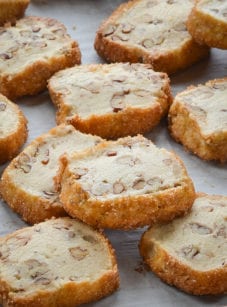
I’ve made these several times – they’re always a huge hit. I’d love to incorporate lemon and ginger! Any tips on the best measurements to use? I’d be so grateful! Thank you for the best recipes on the planet!
Glad you like them! I’d incorporate one teaspoon lemon zest. Regarding the ginger, what form were you considering using?
I was thinking candied ginger, but I wasn’t sure if “bits” would mess up the delicate structure or texture of the scone…
I think the candy ginger would be nice here. Please LMK how they turn out if you try it!
These are great! Served with some homemade cherry jam and some whipped cream on the side. The scones are light and that’s from using cake flour. I followed the recipe and wouldn’t make any changes.
Just made these to cheer up a dreary Saturday morning. Used the flour and cornstarch trick since I didn’t have cake flour on hand. Fast, easy, and amazing as always–so light! My husband agreed–he said they were excellent! Thanks again, Jenn!
Yes, cake flour!!! Makes all the difference! Wish I’d known this a long time ago. My scones turned out much lighter, rose a little higher and didn’t spread out as much. I’ll never use AP flour again.
Hi Jenn! I have a question about your mini savory cheddar dijon scone recipe from your first cookbook (delish!). I just put them in the freezer and then spotted the cup of cheese that I forgot to add (ugh😑 ). Can I sprinkle it on top before I bake them or should I just forget about it? Thanks so much!!
Hi Kathy, I do stuff like that way too often! Yes, I would sprinkle the cheese on top before you bake the scones. Glad you like them!